Fall07
Back to VCBS First Page
INSIDE THIS ISSUE:
Covered Bridge Community News Notes Covered Bridge Fiction or Fact - Trusses We Have Books
Membership Column President's Column
Events POW/MIA Network
by Joe Nelson
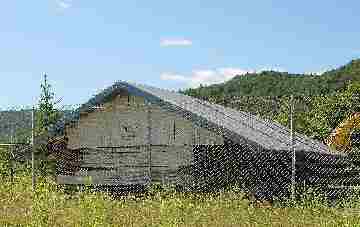 |
photo by Scott Perry, August 2003 |
Montgomery, VT, August 21, 2007 - "The status of the bridge
is unchanged," wrote Scott Perry, Montgomery selectman.
"[It's] still in storage with hopes to reconstruct it at the site of
our new municipal water plant."
"The good news is that the final phase of the water project
is now underway after a few delays, and we should be on line
by March of 08. I'm not sure, but we may try to move the
bridge, which is bundled or palletized, to the site in the late fall
or early winter once the ground freezes. Thanks for your
interest and offer of financial help," Scott wrote in an email
answering Joe Nelson's request for status.
The project status can be viewed through the town web site
at http://www.vermont-towns.org/montgomery/.
In October, 2002, the Montgomery Historical Society and
the town selectboard, on the advice of a consultant hired to
inspect the bridge, took it down to prevent it from collapsing
into the gorge over winter. The bridge was dis-assembled and
stored in the yard of the St. Onge Construction Co. A group of
townspeople has been charged by the Selectboard to
recommend where the bridge should ultimately be placed and
provide a cost estimate for the project.
The Vermont Covered Bridge Society at the October 25, 2003
Annual Business passed a motion to authorize $500 toward the
restoration of the Hectorville Bridge made and seconded by Rae
Laitres and Marge Converse, respectively. The VCBS Board of
Directors approved the initiative made by the membership and
increased the pledge to $1000, the pledge to be paid when the
plans for the placement of the bridge are completed.
The bridge was originally built in Montgomery Village in
1883 by Savanna and Sheldon Jewett and was moved over the
South Branch of the Trout River in 1899 to serve Gibou Road
and a tub factory. The bridge was ultimately bypassed with a
concrete and steel span. The truss began to fail, probably in the
1950s, and a jury rig was added to the truss in the form of
inverted "Vs" with steel cables attached to a log slung under the
floor.
A Look Back . . . .
by Margaret Foster*
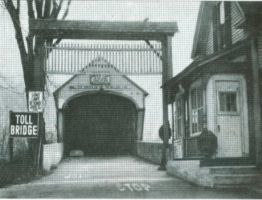 |
Photo from CRVSCBS Bulletin Un-attributed, undated |
Until 1943 the Windsor - Cornish covered bridge was the
last covered TOLL bridge over the Connecticut River. On June
1st of that year, it was made free, the State of N. H. having
purchased it from the holding company in 1935 for the sum of
$10,000. As gasoline became scarcer and scarcer the state
discovered that it was spending more to collect tolls for passage
than tolls were returning in income. Since the cost had already
been cleared, plus the cost of maintenance, it was decided to
"free" the bridge. This was done with elaborate and appropriate
ceremonies.
The old bridge was built in 1866 - the fourth on this site and
the second to be a covered structure. The other three bridges
were carried away in "spring freshets". The center pier has a jog
which shows how much lower were these than the present
bridge. This higher [bridge] has stood in spite of 7 inches of
water flowing thru it at the time of the 1927 flood. A bit of the
eastern approach was washed out at this time. Had the flood
lasted longer, the bridge would have gone. Again on March 6th
and 7th of this year (1964) the bridge was threatened by great
chunks of ice which came down from the White River. These
milled about with considerable force and nearly reached the
floor of the bridge.
The collection of tolls makes an interesting study. Until the
railroad came, about 1850, all livestock for the Boston market
was driven on foot. This provided a good source of income.
Cattle at 2 cents a head, and sheep at one-half cent does not
sound like much, but in 1838, one of the best years, toll was
paid on 14048 sheep and 2208 cattle. There were also several
coaches a day, and these provided a steady income.
The gate was a distinguishing feature. It suggested a
guillotine. Control was by a rope from the toll house porch. The
story is told of a gatekeeper who used his spare time knitting,
as many men did in those times. One day a woman decided the
tolls were too high and she was not paying them. She lashed her
horse and attempted to run the bridge. The gatekeeper reached
for the rope and the gate came down between the horse and the
buggy. The frightened horse did his best to kick it into bits. The
woman finally paid her toll and the cost of repairing the gate.
The keeper never missed a stitch!
Tolls were always a point of dissension. Toll rates for
individual crossings were set by the charter, but the keepers had
much leeway. Several of them set up rates for families who
used the bridge often. This was a convenience for both the
patrons and the collectors. Since there was no set rule, much
depended on the relationship between the toll taker and the toll
giver.
The charter set the toll for a foot passenger at 2 cents.
However, the story is told that when Windsor was "dry" and
Cornish was "wet", the keeper charged 2 cents to leave
Windsor, and 3 cents to return, both to be paid on leaving
Windsor. Presumably he had had experience with patrons who
had left all their cash in Cornish.
Do you remember crossing a covered bridge when you were
young? They were known to children as "wishing" bridges.
You were supposed to shut your eyes and make a wish as you
entered and to keep your eyes closed until you came out at the
other end. If you could do this you would get your wish. Of
course other youngsters tried to make you open your eyes by
saying such things as, "See the elephant".
Many covered bridges were known as "kissing" bridges and
the Windsor-Cornish span is no exception. The old saying goes,
"If the bridge is long enough, and the horse is slow enough, and
the girl is willing enough, a chap should get four". And
doubtless he would have in this structure - the longest covered
bridge in New England.
There is an interesting law suit concerning this bridge. Since
the charter was granted before the days of automobiles, no rate
was set up for this form of transportation. A motorist ran up a
sizeable bill and refused to pay it, claiming it was illegal to
charge for autos, there being no rate prescribed in the charter.
A decision in a similar case brought in New York State found
for the motorist. In Vermont a comparable decision was on
record and was based on the New York case. However this was
tried in New Hampshire and the motorist lost. As a result of this
case, legal rates were set up for cars.
Many people do not realize that the dividing line between
Vermont and New Hampshire is the low water mark on the
western, or Vermont side of the river, This means that New
Hampshire owns most of the bridges over the Connecticut,
though it has been reported that in some cases Vermont has to
pay the cost of building and maintaining the bridges to the state
line. This explains why the above case was tried in New
Hampshire.
The toll records are an interesting study. They tell of a
group crossing the bridge in 1831 for the purpose of "wolf
hunting". One wonders if they were successful. The records
also show that Lafayette crossed here in 1825. President Hayes,
Theodore Roosevelt and Wilson also used this crossing. Many
of these did not use the present bridge, of course.
James F. Tasker, builder of the Windsor-Cornish Bridge
could neither read nor write. He left no records or account
books to help us with his life story. He is reputed to have built
many of the covered bridges in these parts, including the
recently repaired Meriden Bridge and several in West Windsor,
Weathers field, Cornish, Plainfield and Windsor. He had heavy,
black, bushy eyebrows and a black beard, and was evidently a
very stern man. The neighborhood children were afraid of him.
Valley residents differ in their feelings towards the old
bridge. A few are sentimental and would like to keep it. More
would be glad to see it replaced by a modern span. Perhaps a
compromise could be reached -- a new bridge for the traveling
public but the old bridge kept as an example of old time living.
It will be 100 years old next year and it is to be hoped that New
Hampshire will give the old bridge a birthday party. It certainly
deserves this much attention for the many years it has served so
faithfully.
[*This article was taken with permission from the Fall, 1964 issue of
the Connecticut River Valley Covered Bridge Society Bulletin,
official publication of that society - Ed.].
 |
by Trish Kane
August 30, 2007 - As some of you may be aware, Sullivan
County, NY has three historic covered bridges eligible for
listing on the State and National Register of Historic Places.
Being listed is an honor and provides some level of protection
for our bridges.
We are pleased to report that the NY State Review Board
has now listed the Beaverkill Covered Bridge -- NY-53-02 on
the State Register of Historic Places. They will now forward the
nomination to the Keeper of the National Register in
Washington, DC. If approved, the property will be listed on the
National Register as well.
It has been our experience working with the New York
State Office of Parks, Recreation and Historic Preservation that
if a bridge is accepted on the state level, if will more than likely
be accepted at the National level as well.
This is great news not only for the Beaverkill Covered
Bridge, but for all of us working so diligently to preserve our
bridges. The Friends of the Beaverkill group should be
commended for all their hard efforts. Congratulations to each
of them on this successful endeavor.
Penalties Stiffened Historic Structure Arson
Bucks County, Pa., June 28, 2007 - State Rep. Paul Clymer
(R-Bucks) has introduced legislation to increase penalties for
those who set fire to a historic structures in Pennsylvania.
"In Bucks County last month, one of our treasured covered
bridges was set on fire in Springfield Township," said Clymer.
"Fortunately, the blaze extinguished on its own before severe
damage was incurred. However, because of the historic
significance of the bridge, as well as other historic structures,
I think increased penalties are needed to deter such crime."
The proposed legislation states that any person intending to
damage or destroy a historic resource belonging to another
would be guilty of a second-degree felony and receive a
mandatory prison term of no less than one year.
An historic resource is defined as a building or structure,
including a covered bridge, which has either been in existence
for more than 100 years or is listed in the National Register of
Historic Places or the Pennsylvania Register of Historic Places.
House Bill 1607 has been referred to the House Judiciary
Committee.
Covered Bridge Reopening Celebration
by Dave Guay
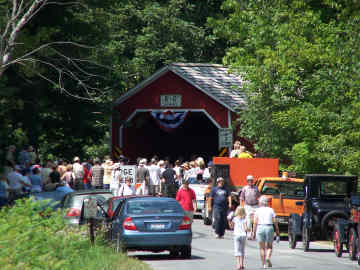 |
Photo by David Guay, August 4, 2007 |
On Aug. 4, 2007, the Washington County Covered Bridge
Advisory Committee held a Gala Re-Opening Celebration to
officially re-open the Rexleigh CB (NY-58-03), Eagleville CB
(NY-58-01) and Buskirk CB (NY-58-04 & NY-42-02).
Buskirk was dedicated first with much fanfare with the
Cambridge Band on hand to play some rousing marches and the
Star-Spangled Banner. Many dignitaries were on hand to give
speeches and to laud those responsible for this event, which
were many. A group of Irish dancers performed for all
assembled. After the ribbon cutting ceremonies, vintage cars,
trucks & even a motorcycle with a sidecar on it went through
the bridges. This was also done at the other bridges being
dedicated that day.
Also, you could stop by the Shushan CB (NY-58-02) to
visit the museum, and sample some freshly made potato chips
that were made by hand with a vintage potato chip making
machine that is on display in the museum.
After all the dedications were finished, all were invited to
come to the "Old County Courthouse" in the village of Salem,
NY for some live music, art vendors, raffles and to purchase
some commemorative t-shirts and a book written by Robert G.
McIntosh titled, "The Covered Bridges of Washington County,
N.Y." and covered bridge memorabilia being sold by the
N.Y.S.C.B.S., and free ice cream (donations gratefully accepted
of course).
The weather was perfect and all seemed to enjoy
themselves. The Washington County Covered Bridge Advisory
Committee should be very proud of the dedication ceremonies.
by Gerald Arbour
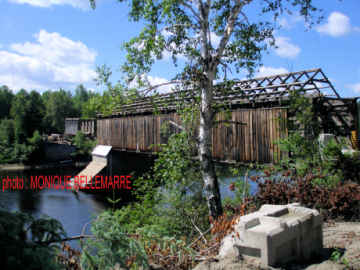 |
Photo by Monique Bellemarre |
August 6, 2007 - The Gareau Bridge, (61-46-01), is on its way
to being torn down. Recent pictures indicate the span has
already been moved to the ground.
A few years ago, this private bridge was offered free to
anyone willing to take care of the bridge. The Nexfor Co. (a
paper company) is the owner of the bridge.
An agreement was quickly reached between local
government, VTT club and outfitters to save the bridge.
Unfortunately, the Company changed their minds and the
bridge will be destroyed. A nice piece of history will be lost.
East Rockhill, Pa., July 5, 2007 - Blooming Glen Road was
closed starting July 2 and will remain closed until late
November as PennDOT begins construction to rebuild Mood's
Covered Bridge in East Rockhill Township, Bucks County.
During the road closure, Blooming Glen Road through
traffic will be detoured over Branch Road, Walnut Street and
5th Street.
Three years ago, Mood's Covered Bridge was destroyed by
arson. While the fire totally destroyed the covered bridge
trusses, roof, and siding, the self-supporting roadway remained
serviceable. The bridge was reopened to traffic in August,
2004.
A replication of the original span will be built with
$732,796 in funds provided by the state. The bridge deck will
be replaced and the supporting steel beams repainted. The new
structure will be modified to provide more height clearance and
fire regardant will be applied. The covered bridge will be 14
feet wide and 120 feet long .
When construction is completed, Bucks County will take
ownership and East Rockhill Township will insure the bridge.
Approximately 2,000 vehicles use the bridge daily. Lycoming
Supply, Inc. of Williamsport, Pa. is the general contractor for
the project.
PennDOT had rehabed the bridge in 1997 replacing the
original bridge floor with a self-supporting deck structure on
steel beams. The covered bridge portion of the structure was
refurbished with modern materials, the work done by contractor
Lycoming Supply. The contractor will use the same
specifications for the new bridge.
According to the Word Guide to Covered Bridges
published by the National Society for the Preservation of
Covered Bridges, Moods bridge was built in 1873 using the
Town truss to cross the East Branch of Perkiomen Creek in one
126-foot span.
[WGN 38-09-02]
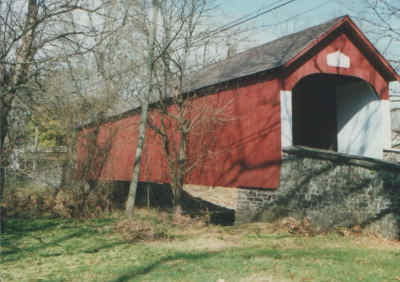 |
Bucks County, Pa., June 26, 2007 - The Springfield Township
Board of Supervisors passed a resolution that Knecht's Covered
Bridge is recognized as ". . . a high value asset and symbolic of
Springfield's rural character . . .." calling for Bucks County to
take steps to protect the bridge.
The board's resolution asks the county for assistance with
the installation of fire detection and surveillance equipment at
the bridge, in acquiring grants and inclusion in the 2008
National Historic Covered Bridge Preservation Program. The
board also asked elected officials to elevate Knecht's Bridge as
an "extraordinarily high risk historic property."
The resolution acknowledged the elected officials who
introduced House Bill 1607, calling for stiff penalties for those
commit arson on historic structures in Pennsylvania. The bill
states that any person who intentionally starts a fire or
explosion to destroy or damage a historic resource, or aids
another party to do so, will be committing a second degree
felony.
Bucks County has been the home of twelve covered bridges
and a unique boxed pony wooden bridge. Arsonists have attempted
to burn Knecht's Bridge twice in the past 26 months.
Bucks County has lost three covered bridges to intentionally set
fires:
Haupt's Mill Bridge, WGN 38-09-01, a 107-foot town truss
span built in 1872 to cross Durham Creek near Springfield,
destroyed 1985 and not rebuilt; Mood's Bridge, WGN 38-0907,
was burned in 2004 and is now being rebuilt, a 126-foot
Town truss span built in 1873 to cross Mood Creek East
Rockhill; The Schofield Ford or Twining Ford Covered Bridge,
now located in Tyler State Park, WGN 38-09-13, 166 feet long
in two spans, one queen post truss, one Town truss, to cross
Neshaminy Creek was arsoned in 1991 and rebuilt in 1997.
[Our thanks to Doris Taylor for sharing this, and the other
Pennsylvania news items - Ed.]

Question # 4 -- Why are so many different truss types used in Covered Bridge construction?
John Weaver, VT
Many types of trusses were used in covered bridge construction
-- Paddleford, Haupt, Howe, Long, plank (Town) lattice,
kingpost, queenpost and Pratt trusses as well as Burr arch spans
and combinations of these forenamed types. Several factors
influence the final type of truss constructed, including material
availability, span length, and level of craftsmanship required.
Bridge spans up to 30 feet were often made with kingpost
trusses, spans 30-60 feet with queenpost trusses, and spans of
greater lengths with the remaining truss types or combinations
of truss/arch systems. These types of trusses and combined
systems perform well for the span lengths indicated.
Concerning craftsmanship -- plank lattice trusses are, by
connections and configuration easier to fabricate than other
types of trusses or combined systems which have complex
joinery and sizable timber members.
Material availability often plays a role in truss type
determination. If sizable structural timbers were not readily
available, then sawn planks may have been easily obtained
from local lumber mills. Probably, craftsmanship and material
availability influenced the great number (approximately 40% of
today's existing covered bridges) of plank lattice trusses in
Vermont.
Joseph Conwill, ME
1. Necessity: Certain trusses such as the Queenpost are more
limited as to span length; others are difficult to frame well.
2. Sociology of invention: I hope this doesn't sound overly
professor-ish. But, when a technology is perceived as cutting-
edge, this invites a host of inventors to try out their skills on it.
Much of the variety in bridge trusses may be explained simply
by this. What real purpose was served by the Brown truss, for
example? Or the Partridge truss?
3. Regional preference. Once a particular style demonstrated
its usefulness, other builders in the same area tended to keep
with it. The Paddleford truss is an example of a regional style,
and so is the New Brunswick strutted-Burr truss. There is no
reason why Town or Burr trusses couldn't have been used in
place of the Paddleford; or Howe trusses in place of the New
Brunswick strutted-Burr. But in those cases, regional
preference sometimes favored the more unusual style. This too
has enriched our heritage of truss types.
Robert Durfee, P.E. -- NH
I would say that the truss type used for a particular Covered
Bridge was dependent on the builders preference, cost,
availability of skilled labor, span length, and patent
considerations.
Truss types commonly used in New England Covered
Bridges include: Town Lattice, Howe, Long, Paddleford, Burr
(Arch), Pratt, and Queenpost.
Most of these truss types (except Queenpost and
Paddleford) were protected by patents. The truss designer
collected royalties from anyone who used his truss on a bridge.
Patent rights lasted for 20 years, after which, anyone could use
that truss type without paying royalties. To avoid paying
royalties, the builder may have used a truss that had no patent,
an expired patent, or developed his own unique truss type.
Some early truss patents includes Theodore Burrs patent of his
arch truss in 1817, and Ithiel Town's patent of the lattice truss
in 1820 and later in 1835.
Some trusses required more skilled labor (bridge wrights
with timber joinery skills) than others. Town lattice trusses
were said to require the least amount of skilled labor, since the
joints are simple wood trunnel (peg) connections. On the other
hand, the Burr Arch and Paddleford trusses have intricate
connections (mortise and tenon, rabbet and scarf joints, etc.),
requiring a lot of joinery, and thus needed skilled bridge
wrights.
We know that several local bridge builders in New England
built more than one bridge. Builders seemed to stayed with the
one truss type they were comfortable with, or had experience
with (i.e. builders preference).
For shorter bridge spans, up to about 60 feet, the Queenpost
was applicable and economical. For longer spans, the Town
Lattice was expandable to long lengths and multiple spans. The
Howe and Pratt truss were known to be able to support heavy
loads, and were used on early railroad bridges.
With all these considerations, I can understand why so
many different truss types were used. Each bridge site had
different conditions and considerations of which truss to use.
The book "Covered Bridges of Vermont" by Ed Barna, has a
good discussion on the development of bridge
designers/builders in New England and the trusses they
developed. Also, the poster "Trusses", by the Historic American
Engineering Record (HAER No. T1-1) offers a good display of
the many truss types used for bridges, providing information on
when these trusses were developed, and the typical span length
they could support.
Phil Pierce, P.E. - NY
I do not claim to be much of a historian, but I do have a lot of
experience with bridges and quite a bit of experience with
covered bridges. So here goes from that perspective:
There are some 16 configurations of trusses used to support
extant covered bridges, plus some variations thereon. Many of
the configurations were developed in the early part of the 19th
century, prior to the development of rigorous analysis concepts
for trusses. I believe that some "new" configurations were
developed by builders experimenting with variations of
previously developed and published configurations to take
advantage of a perceived improvement in strength and/or
constructability. Certainly some builders would simply be
unaware of the developments of others and may have developed
something slightly different on their own without specifically
attempting to improve other's work (while many of the
prominent builders of that time were well versed in their craft,
publications were somewhat limited, certainly dissemination of
the information was not as convenient as we are used to now).
Also, some of the configurations were developed to take
advantage of new materials as they became more readily
available -- e.g. Howe's combination of wrought iron with
timber over Long's all timber truss. In another vein, some early
truss developers were shrewd business people who realized that
getting a patent on a new configuration might be financially
advantageous, regardless of its popularity.
In a way, the evolution of truss development is similar to
the continuing evolution of bridge engineering forever
challenged to look for new ways to use "state-of-the-art"
materials, knowledge, and experience to better serve society's
need to cross waterways. More recently (in fact, in just the
relatively short span of my professional career), the bridge
industry has developed and significantly improved/modified
cable-stayed bridges.
Sylvain Raymond (ATAWALK) Canada
1- Because everyone of these truss-inventors thought they had
the best, most sophisticated design.
2- Because the patents would bring money...and if a truss was
adopted by, let's say, a railroad company, that would bring in
tons of money!
3- Because depending on location, different wood essences
could be used... in greater or lesser number depending on
durability, permeability and availability.
4- Because some trusses are better for shorter spans, some
others can be used for longer bridges.
5- Because of the availability of specialized labor, it does play
a role in which structure can be erected and where. It is a lot
simpler to erect a Town lattice truss than a Burr Arch which
needs a bigger foundation to start with!
6- Because of funding available... which when all is said and
done, would basically dictate how much could be spent and on
what, the King post truss being el-cheapo... different trusses
where indeed needed to respond to the many varying needs of
the areas where bridges had to be erected.
7- AND FINALLY because it would make covered bridges a
fascinating and varied structure to study!
 A lot of them, fifty plus titles on covered bridges, authored
by Richard Sanders Allen, H.W. Congdon, Eric Sloan, E.W.
Walker, H.R. Howard, and many others. All of these books
were donated to the Vermont Covered Bridge Society by
members or by the descendants of covered bridge fans. They
were given to us not for storage, but for sharing.
|





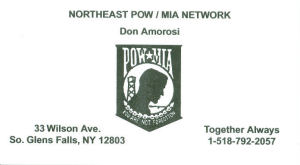
 Joe Nelson, P.O Box 267, Jericho, VT 05465-0267
Joe Nelson, P.O Box 267, Jericho, VT 05465-0267